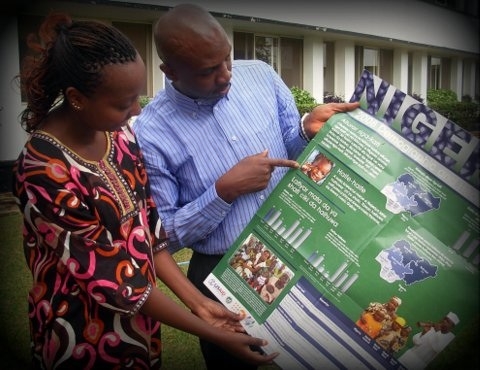
Knight Fellow Declan Okpalaeke, president of the newly formed African Health Journalists Association, is helping lead the way for health data journalism training in Africa. (Photo by Mercedes Sayagues)

Using data, health journalists at Mozambique's weekly newspaper Savana proved that the tradition of "widow cleansing" increases the risk of HIV infection.
Workshop participant Joy Wanja of The Nation in Kenya wrote an award-winning story using health and demographic data to tell the life story of a baby girl and the challenges she will face until adulthood. (Photo by Mercedes Sayagues)
Workshop participant Joy Wanja of The Nation in Kenya wrote an award-winning story using health and demographic data to tell the life story of a baby girl and the challenges she will face until adulthood. (Photo by Mercedes Sayagues)
We were in Entebbe, Uganda, at TAKING MEASURE, a training of trainers workshop organized by Measure DHS, the International Center for Journalists and the African Health Journalists Association, with support from USAID. We were Knight Fellows and media trainers from Cameroon, Ghana, Kenya, Mozambique, Nigeria, South Africa and Uganda, and a trainer from Measure DHS. When we go back to the countries where we work, we will train journalists on how to better use the DHS.
We learned about surveys, samplings and weighting, and refreshed some long-forgotten math skills. Honestly, can you calculate right away the mean and the mode of a series of numbers? Or, say, convert 97 infant deaths per 1,000 live births into an easier number to read, as in, XX children die out of XX? We also worked on producing training tools, such as a highly practical, how-to guide on using numbers, finding story ideas, reading DHS tables to find hidden stories, and navigating the wealth of data and resources available at www.measuredhs.com.
Workshop participant Joy Wanja of The Nation in Kenya wrote an award-winning story using health and demographic data to tell the life story of a baby girl and the challenges she will face until adulthood. (Photo by Mercedes Sayagues)
For example, just before I left Maputo for Entebbe, one of my trainees at the weekly Savana did a story on the decision of the Mozambican Association of Traditional Healers (AMETRAMO) to forbid its members from encouraging widow cleansing, a practice known as kuchinga. This is a ritual where the widow is cleansed from the impurity of her spouse’s death by having unprotected sex with the brother of her late husband – a risky sexual transaction in a country where national HIV prevalence is 13%.
Workshop participant Joy Wanja of The Nation in Kenya wrote an award-winning story using health and demographic data to tell the life story of a baby girl and the challenges she will face until adulthood. (Photo by Mercedes Sayagues)
Now I can teach the reporter to do a line or bar graph visualizing the national HIV prevalence and contrasting it with prevalence among widows and widowers. The next stories will look snazzier with infographics, a tool that is little used by Mozambican media.
When Mozambique launches the full report of its third DHS later in the year, I plan to do a training workshop for journalists who cover health to share these new skills and help them plumb the DHS and visualize its data to produce better stories.
For more on the Entebbe workshop, click here.